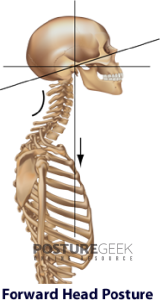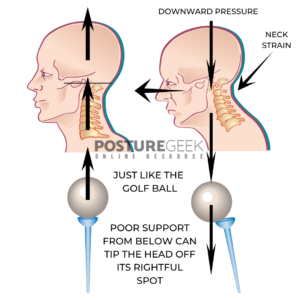Forward Head Posture: what's happening to my posture?

Forward Head Posture (FHP) is a dominant characteristic in many posture types. Although it has its own category, we should think about its implications compared to other posture patterns.
The positioning of the head, neck, and shoulders can be seen as a struggle between these structures and below.
The muscles surrounding the cervical spine, which support the head, have to work harder when you have a Forward Head Posture.
This leads to muscular imbalances over time as your body adapts to find an efficient way to keep your eyes and head looking straight ahead.
Over time, you will find that if this pattern continues, some muscles grow longer and weaker while others shrink and tense.
What does Forward Head Posture look like?

Consider all the time we spend in front of a computer or phone for hours on end.
Forward Head Posture can be seen as a head pushed forward head and down, with an increased neck curvature. The chin may also be sticking out, and the back of the neck may either extend or lean forward.
A Forward Head often comes about from “rounded shoulders” posture caused by slouching. This is a key characteristic of Janda’s Upper Cross Syndrome.
In this postural pattern, the body adapts to the poor alignment by shortening the posterior muscles and lengthening the anterior muscles of the neck. This can lead to a variety of symptoms, including chronic tension headaches and upper back pain.
The very nature of this pattern can create issues with your breathing, such as shallow breathing issues.
-
Forward Head Posture Correction Framed Poster
$55.00 – $159.00 Select options This product has multiple variants. The options may be chosen on the product page
So what are some situations that lead to this pattern?
- Sitting for too long in front of the computer
- Tilting of the pelvis leading to loss of support from below.
- Poorly designed workspace can impact those working from home (WFH).
- Sedentary lifestyle
- Personal and/or environmental stressors
- The effects of gravity
Noticing changes in the position of the head, neck, and shoulders may suggest a need to look closer at how you stand, sit, and walk.
Posture Geek Tweet
Which muscles may be short or tight, influencing your posture? What's overworking?
- Upper Trapezius
- Levator Scapula
- Pectoralis Major and Minor
- Rhomboid Muscles
Which muscles may be weak? What muscles may need to work more?
- Serratus Anterior
- Lower and Middle Trapezius
Forward Head Posture can lead to pain and discomfort.

Consider the following when considering how you might be affected:
- Upper back and neck discomfort and shoulder pain are caused by tight upper back muscles and weak front-of-neck muscle (neck flexors).
- Tightness in the Sternocleidomastoid muscles found at the front of both sides of the neck can also cause a forward head. The tightness can cause neck pain and headaches.
- The problem is compounded by tight pectoral muscles, the chest muscles.
- Shortening of the Levator Scapula, a muscle that raises or depresses your shoulder blades and attaches to each side of the neck. This tightness can lead to upper back discomfort, shoulder pain, and neck pain.
- You may also suffer from chronic headaches if tightness occurs in the Upper Trapezius. This muscle runs from your neck and shoulders and attaches to the base of your skull.
- The movement away from a neutral head posture can lead to a decrease in the range of motion of the neck.
- Poor alignment can lead to undue pressure on joints leading to issues with spinal discs.
- Changes to the positioning of the shoulder girdle can lead to Thoracic Outlet Syndrome.
- The changes to your posture may alter the center of gravity, putting you at greater risk for falls and injuries, as well.
Forward Head Posture: Additional Considerations
More than just the position of the head is affected by this posture and positional pattern.
The head attaches to the neck (cervical spine), which is attached to the upper back (Thoracic Spine), which is attached to the ribs, and the lower back (lumbar spine).
By virtue of skeletal and muscle attachments, by altering the head’s placement, you are, in effect, changing how the rest of the body functions.
Correspondingly, this can be reversed to read that what is occurring below can impact our posture above.
The head is constantly attempting to find an upright, neutral position.
Posture Geek Tweet
The head is constantly attempting to find an upright, neutral position. Not always successfully.
A ‘primitive’ component of the brain is always searching to direct us both forward and upwards. As a means to correct forward head posture.
This mechanism served us well when we were yet to be at the top of the food chain, with predators, a constant threat. But not so necessary now!
While specific primary survival considerations may have changed, our need to search and move forward and up has not.
If poor posture patterns are in place, our ability to straighten up is hampered, with potential faulty messages signaling what good posture looks like. Making it difficult to improve forward head posture.
As always, when considering your posture, remember that no single body region can be altered without affecting the whole body.

